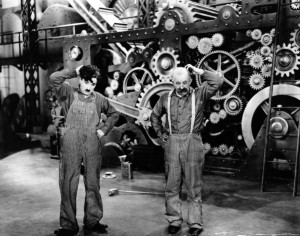[amazon_link id=”B00BIOFLWE” target=”_blank” ]America’s Assembly Line[/amazon_link] by David Nye is fascinating. It’s a history of the origins of the assembly line and mass production, with a strong focus on the motor industry, and traces the spread of mass production through other manufacturing and non-manufacturing sectors (such as housebuilding). The organisation of the line evolved over time, and varied in different places. The imperative of wartime production was an important driver. Post-war, the cybernetics revolution led to far greater automation. On the other hand, the Toyota lean production system brought in greater flexibility for workers on the line.
[amazon_image id=”B00BIOFLWE” link=”true” target=”_blank” size=”medium” ]America’s Assembly Line[/amazon_image]
The public loved the product of the assembly line, affordable mass-produced consumer goods. “In a typical American town, a working class family that couldn’t afford both a bathtub and a car was more likely to opt for a car,” Nye writes of the 1920s. (There’s a parallel with the well known factoid about the greater prevalence of mobile phones than toilets in Indian households now – any kind of means of communication seems peculiarly compelling.) Access to assembly line products, alongside the growth of a suburban middle class, spread far faster in the US than in Europe.
The relationship between machines and workers is an important theme in the book. Although Henry Ford famously paid $5 a day, double the going rate, many workers left before they qualified for it, so hard was the work. The unions had to fight hard to get recognition in the industry. The factories were notorious for robbing workers of any autonomy, and for speeding up the line to extract greater effort. Although 1927 had even brought a symphony to the Model T (premiered by the Boston Symphony Orchestra) he pressure of the assembly line soon became a frequent theme in films, songs and TV – Charlie Chaplin’s Modern Times being a prominent example.
The monotony and conformity of mass production also meant it was slow to spread in Europe, where the markets were anyway far smaller and therefore less able to sustain huge volumes. And there was a culture clash: “British workmen regularly stopped the assembly line for tea breaks.” More importantly, though, “No European nation could develop an American style production system unless it also embraced mass consumption.” None did before the war – the Soviet Union was most interested in Ford’s methods, but could not provide the workers capable of doing the jobs.
Through the post-war era, opinion divided between the welcome given to consumer products and welfare capitalism – Ford also offered savings plans, medical care in the factory, educational programmes – and the cultural distrust of conformity and the alienation of labour on the assembly line. The latter was, again, most pronounced in Europe. And yet European consumers were just as keen on cheap goods. Vice President Richard Nixon famously showed Nikita Kruschev around a model home at the American National Fair exhibition in Moscow in 1959 – Francis Spufford’ superb book [amazon_link id=”0571225241″ target=”_blank” ]Red Plenty[/amazon_link] brings this scene to life. Nixon presented Kruschev with a nice paradox about the benefits of mass produced goods and homes, in that American consumers had a vast choice: “We do not wish to have decisions made at the top by government officials who say all homes should be built in the same way.”
“Commodity fetishism meant that there was a widespread desire for what the assembly line produced but an equally widespread disdain for the work involved,” writes Nye. At the same time, concern began to grow – in line with automation – that the jobs involved were vanishing anyway. The fear of robots eliminating the need for humans emerged around this time.
No matter. Consumerist capitalism was even more heavily criticised by the counter-culture of the 1960s, culminating in 1968. And by the 1970s the far greater flexibility of the Toyota system was outperforming the rigidity of Fordism. By 1990, Volvo was advertising its abandonment of the assembly line. It had small teams assembling an entire vehicle. It took 4 months to train a Volvo worker, compared to 4 hours on a conventional line, but worker turnover was low and productivity high, and problems solved by individual teams with no spillover to the rest of the plant.
Yet the effect of automation on jobs remained a constant. The western economies ‘deindustrialised’. Detroit started its gothic decline – so well captured by photographers Yves Marchand and Romain Meffre in their book [amazon_link id=”3869300426″ target=”_blank” ]The Ruins of Detroit[/amazon_link]. and by the incomparable Bruce Springsteen, voice of blue collar America. Nye concludes: “Americans accepted mass production as though it were part of the natural order, with its subdivision of work, its interchangeable parts, and its organization of everyday life in terms of efficiency and productivity. Year after year they expected higher wages, more consumer goods and a general acceleration of experience. By 2013, however, this was an outdated and unsustainable economic order. The classic assembly line had been based on a large semi-skilled working class, not on robots and outsourcing.”
[amazon_image id=”3869300426″ link=”true” target=”_blank” size=”medium” ]The Ruins of Detroit[/amazon_image]
Robots, in short, don’t buy washing machines and fridges, and all the skills of the Mad Men won’t change that.
This book is an excellent companion read to the current robot debate – nicely summed up in this Economist article.

